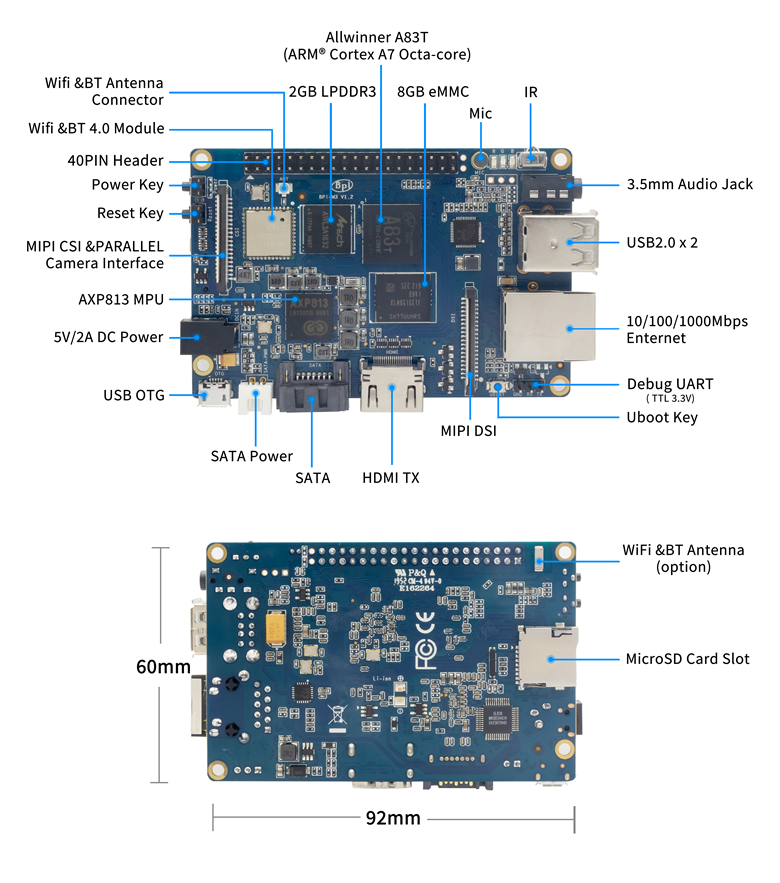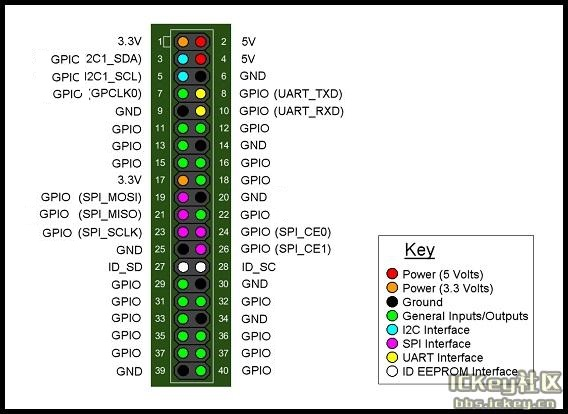Difference between revisions of "Banana Pi BPI-M3"
(→Hardware interfact) |
(→Hardware spec) |
||
| Line 21: | Line 21: | ||
==Hardware spec== | ==Hardware spec== | ||
| + | {| class="wikitable" | ||
| + | |- | ||
| + | ! | ||
| + | ! Banana Pi BPI-M3 | ||
| + | |- | ||
| + | ! CPU | ||
| + | | Allwinner A83T ARM Cortex-A7 Octa-Core 1.8 GHz, 512KB L1 cache and 1MB L2 cache | ||
| + | |- | ||
| + | ! GPU | ||
| + | | PowerVR SGX544MP1 Comply with OpenGL ES 2.0 OpenCL 1x, DX9_3 | ||
| + | |- | ||
| + | ! Memory | ||
| + | | 2GB LPDDR3 (shared with GPU) | ||
| + | |- | ||
| + | ! Storage | ||
| + | | On Board 8GB eMMC Flash, Micro SD-Card slot, SATA 2.0 Port (USB-to-SATA bridge)<ref name="USB-to-SATA bridge">[http://forum.banana-pi.org/t/banana-pi-bpi-m3-2nd-giveaway-enter-for-a-chance-to-win/491/32 forum.banana-pi.org The M3 has no SATA support], its USB-to-SATA bridge is many times slower than the native SATA implementation of M1/M1+</ref> | ||
| + | |- | ||
| + | ! Network | ||
| + | | 10/100/1000 Mbit/s Ethernet (Realtek RTL8211E/D) + Wi-Fi 802.11 b/g/n (AP6212) + Bluetooth BT4.0 | ||
| + | |- | ||
| + | ! Video Input(s) | ||
| + | | A CSI input connector allows for the connection of a designed camera module | ||
| + | |- | ||
| + | ! Video Output(s) | ||
| + | | HDMI 1.4 (Type A Full), MIPI Display Serial Interface (DSI) for raw LCD Panel | ||
| + | |- | ||
| + | ! Audio Input(s) | ||
| + | | On board microphone | ||
| + | |- | ||
| + | ! Audio Output(s) | ||
| + | | 3.5mm jack and HDMI | ||
| + | |- | ||
| + | ! USB ports | ||
| + | | USB 2.0 PORT (x2), USB OTG (x1) | ||
| + | |- | ||
| + | ! Remote | ||
| + | | IR Receiver (x1) | ||
| + | |- | ||
| + | ! GPIO | ||
| + | | 40 Pin Header : GPIO (x28) and Power (+5V, +3.3V and GND). Some of I/O Pin can be used for specific functions as UART, I2C, SPI or PWM | ||
| + | |- | ||
| + | ! Switches | ||
| + | | Reset, Power and U-boot | ||
| + | |- | ||
| + | ! LED | ||
| + | | Power Status and 8P8C | ||
| + | |- | ||
| + | ! Power Source | ||
| + | | 5 volt @2A via DC Power and/or Micro USB (OTG) | ||
| + | |- | ||
| + | ! Size & Weight | ||
| + | | 92x60mm, 48g | ||
| + | |- | ||
| + | ! OS | ||
| + | | Android and Linux | ||
| + | |} | ||
==GPIO PIN define == | ==GPIO PIN define == | ||
Revision as of 23:58, 6 May 2018
Contents
Introduction
Banana Pi M3 is a super charged single board computer with an Octa-core processor and 2GB of RAM. Along side the elite processing unit, it features Gigabit Ethernet, 2 USB, SATA, WiFi, Bluetooth, and HDMI connection. It can run on a variety of operating systems including Android, Lubuntu, Ubuntu, Debian, and Raspbian.
Being a brother of the power hungry M2, the M3 does not want to rest while his brother goes to acquire two more cores. The M3 secretly mastered the powerful art of Octa-core to best even the M2. Unlike his careless brother, the M3 did not lose his SATA port.
Banana Pi is an open platform device, it is for anyone who wants to play and build with developer technology instead of simply using consumer technology. Backed by our community, starting a project and building servers is fun and rewarding. We welcome all companies, DIYers, and tech loving people within our community! Together, we can make a difference, we can discover our passions, inspire others, and build a practical project.
Key Features
- Allwinner A83T Octa-core 1.8GHz Powerful CPU.
- 2 GB LPDDR3 memory.
- 8 GB eMMC storage.
- WiFi & Bluetooth onboard.
Getting Start
Hardware
Hardware interfact
Hardware spec
| Banana Pi BPI-M3 | |
|---|---|
| CPU | Allwinner A83T ARM Cortex-A7 Octa-Core 1.8 GHz, 512KB L1 cache and 1MB L2 cache |
| GPU | PowerVR SGX544MP1 Comply with OpenGL ES 2.0 OpenCL 1x, DX9_3 |
| Memory | 2GB LPDDR3 (shared with GPU) |
| Storage | On Board 8GB eMMC Flash, Micro SD-Card slot, SATA 2.0 Port (USB-to-SATA bridge)<ref name="USB-to-SATA bridge">forum.banana-pi.org The M3 has no SATA support, its USB-to-SATA bridge is many times slower than the native SATA implementation of M1/M1+</ref> |
| Network | 10/100/1000 Mbit/s Ethernet (Realtek RTL8211E/D) + Wi-Fi 802.11 b/g/n (AP6212) + Bluetooth BT4.0 |
| Video Input(s) | A CSI input connector allows for the connection of a designed camera module |
| Video Output(s) | HDMI 1.4 (Type A Full), MIPI Display Serial Interface (DSI) for raw LCD Panel |
| Audio Input(s) | On board microphone |
| Audio Output(s) | 3.5mm jack and HDMI |
| USB ports | USB 2.0 PORT (x2), USB OTG (x1) |
| Remote | IR Receiver (x1) |
| GPIO | 40 Pin Header : GPIO (x28) and Power (+5V, +3.3V and GND). Some of I/O Pin can be used for specific functions as UART, I2C, SPI or PWM |
| Switches | Reset, Power and U-boot |
| LED | Power Status and 8P8C |
| Power Source | 5 volt @2A via DC Power and/or Micro USB (OTG) |
| Size & Weight | 92x60mm, 48g |
| OS | Android and Linux |
GPIO PIN define
Banana Pi BPI-M2 Berry has a 40-pin GPIO header that matches that of the Model Raspberry Pi 3. Following is the Banana Pi GPIO Pinout:
Software
Android
Linux
Opnewrt
TinaLinux
Allwinner Tina-IoT os for BPI-M2 Ultra/BPI-M2 Berry

